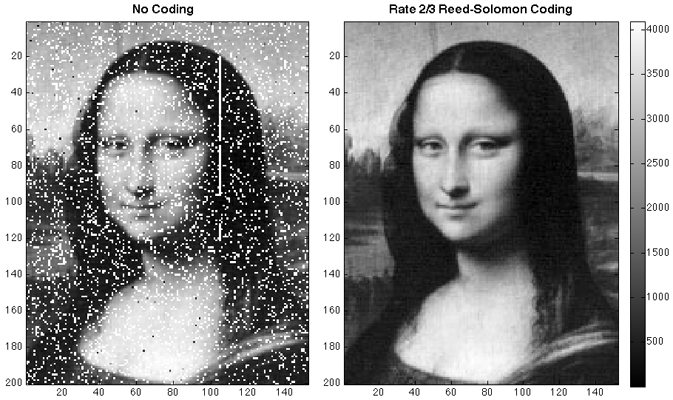NASA Demonstrates Laser Data Communication With Lunar Orbiter
NASA has made its first step beyond its more than 50 year-old radio wave-based Deep Space Network (DSN), to communicate with spacecraft.
The organization said that it successfully demonstrated that data can piggyback on its tracking lasers and transmit information at "planetary distances".
The demonstration consisted of individual pixels of an image, the portrait of Mona Lisa, that were sent via light impulses to the Lunar Reconnaissance Orbiter (LRO), which travels about 240,000 miles away from Earth. By knowing the location of the LRO via a tracking beam, NASA was able to use the laser simultaneously for data communication and tracking.
"This is the first time anyone has achieved one-way laser communication at planetary distances," said Lunar Orbiter Laser Altimeter's principal investigator, David Smith of the Massachusetts Institute of Technology. "In the near future, this type of simple laser communication might serve as a backup for the radio communication that satellites use. In the more distant future, it may allow communication at higher data rates than present radio links can provide."
The data transmission required the image to be reconstructed and corrected by the LRO, but the complete image was eventually received. The image had a resolution of 152 pixels by 200 pixels. "Every pixel was converted into a shade of gray, represented by a number between zero and 4,095," NASA said. "Each pixel was transmitted by a laser pulse, with the pulse being fired in one of 4,096 possible time slots during a brief time window allotted for laser tracking." The achieved data transmission rate was 300 bits per second.
Current radio transmission data rates heavily depend on the distance the signal has to travel. For example, signals from Voyager 1, the spacecraft currently farthest away from the distance, need more than 30 hours to reach Earth. The DSN is said, however, to deliver a "few megabits per second" of bandwidth at this time with more modern devices, such as the Mars rovers. In the future, NASA hopes to achieve as much as 600 Mb/s bandwidth with its space network.
Contact Us for News Tips, Corrections and Feedback
Get Tom's Hardware's best news and in-depth reviews, straight to your inbox.

Wolfgang Gruener is an experienced professional in digital strategy and content, specializing in web strategy, content architecture, user experience, and applying AI in content operations within the insurtech industry. His previous roles include Director, Digital Strategy and Content Experience at American Eagle, Managing Editor at TG Daily, and contributing to publications like Tom's Guide and Tom's Hardware.
-
A Bad Day Good to hear that NASA hasn't been killed by the major budget crunches. Hate to be an engineer there though. Watching coworkers go and working in relatively empty areas has to be lonely, and paranoid-inducing.Reply
The DSN is said, however, to deliver a "few megabits per second" of bandwidth at this time with more modern devices, such as the Mars rovers. In the future, NASA hopes to achieve as much as 600 Mb/s bandwidth with its space network.
Some decent error-correction coding and looks it's viable...
Unless if some jerk somehow determines the exact location of the laser and puts a lead sheet in its path. -
SirGCal 300bps... That is Horribly slow. I don't see a realistic application for something of that speed with any real data size. I.E. video-chat with deep space craft, internet for same, etc. Perhaps basic text but even images at that speed would be extremely painful. Most people old enough to remember dialup modems being common place, they were magnitudes faster. However, this is a first step. We'll see where it goes.Reply -
mbreslin1954 "For example, signals from Voyager 1, the spacecraft currently farthest away from the distance, . . ."Reply
Huh?
Currently farthest away from the distance? Someone needs proof-readers. -
calmstateofmind francesmmy neighbor's mother makes $63 every hour on the internet. She has been out of a job for five months but last month her income was $13516 just working on the internet for a few hours. Read more here www.pie21.comReply
She must have her own site, if you know what I mean... -
bluekoala SirGCal300bps... That is Horribly slow. I don't see a realistic application for something of that speed with any real data size. I.E. video-chat with deep space craft, internet for same, etc. Perhaps basic text but even images at that speed would be extremely painful. Most people old enough to remember dialup modems being common place, they were magnitudes faster. However, this is a first step. We'll see where it goes.300bps is actually a dial-up speed. I work for a telco and I can tell you that 300bps is amazing considering this thing orbits THE FRICKEN MOON.Reply
-
mrmaia SirGCal300bps... That is Horribly slow. I don't see a realistic application for something of that speed with any real data size. I.E. video-chat with deep space craft, internet for same, etc. Perhaps basic text but even images at that speed would be extremely painful. Most people old enough to remember dialup modems being common place, they were magnitudes faster. However, this is a first step. We'll see where it goes.Reply
The link is made for communication, not your everyday porn videos. It's a laser beam aimed 240k miles goddamn away from Earth, what did you want? A cable connection? -
manofchalk Potential fix to the bandwidth issue, multiple lasers.Reply
Though I'm sure there are much smarter people than I in NASA who can point out every reason why that wouldnt work and/or is unfeasible if it hasnt alerady been done. So I'l just be quiet now.
At the very least we now have an effectively instant method of communication, sure even a primitive use of the laser firing off Morse code would be faster than radio at these distances. -
Achievable bandwidth over any distance will not have any effect of the time it takes for the signals to go from one place to another. Pls correct the phrasing.Reply
> Current radio transmission data rates heavily depend on the distance the signal has to travel. For example, signals from Voyager 1, the spacecraft currently farthest away from the distance, need more than 30 hours to reach Earth. The DSN is said, however, to deliver a "few megabits per second" of bandwidth at this time with more modern devices, such as the Mars rovers. In the future, NASA hopes to achieve as much as 600 Mb/s bandwidth with its space network. -
Cutha Reply9447731 said:At the very least we now have an effectively instant method of communication, sure even a primitive use of the laser firing off Morse code would be faster than radio at these distances.
Both radio and laser are part of the electromagnetic spectrum and both travel at the speed of light, neither is instant.
